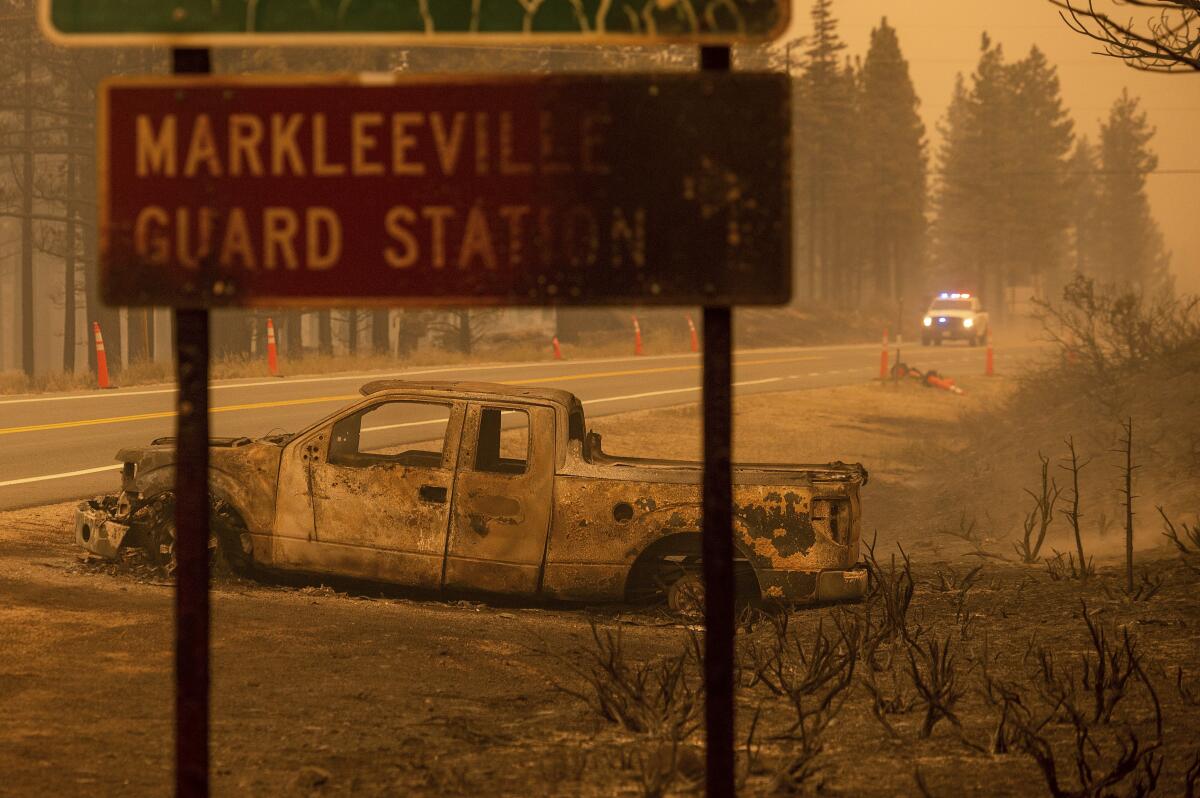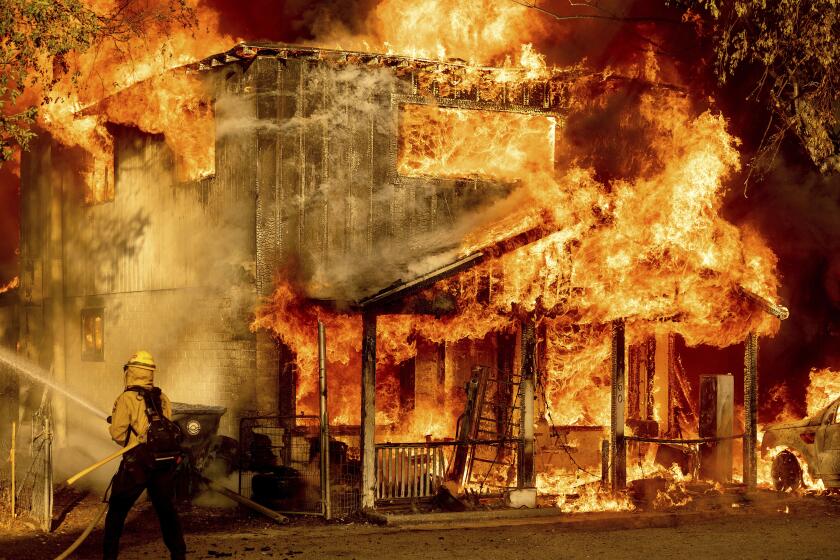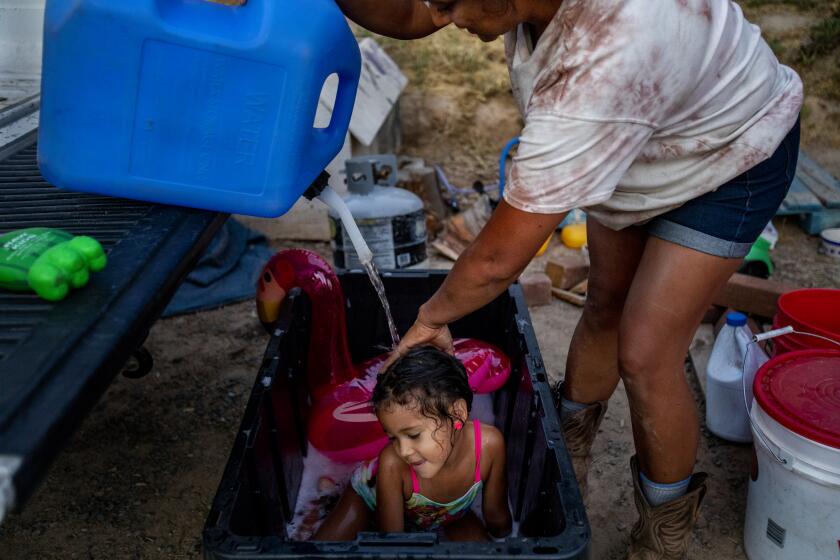Forest Service changes ‘let it burn’ policy following criticism from western politicians

SACRAMENTO — Facing criticism over its practice of monitoring some fires rather than quickly snuffing them out, the U.S. Forest Service has told its firefighters to halt the policy this year to better prioritize resources and help prevent small blazes from growing into uncontrollable conflagrations.
The change came days after politicians in California and the West, including Gov. Gavin Newsom, publicly challenged the “let it burn” approach after the Tamarack fire ignited last month, as The Times detailed in a story Sunday.
It also comes as fierce winds are expected to collide with bone-dry conditions at the massive Dixie fire in Northern California, already California’s eighth-largest in recorded history at more than 270,000 acres, leaving firefighters bracing for further spread during a red flag warning that goes through Thursday. Currently, the blaze is 35% contained with nearly 5,000 personnel working to stop its advance.
Instead of letting some naturally caused small blazes burn, the agency’s priorities will shift this year, U.S. Forest Service Chief Randy Moore indicated to the staff in a letter Monday. The focus, he said, will be on firefighter and public safety.
Moore, who took over as head of the agency last month, wrote that the 2021 fire season is “different from any before” and posed a “national crisis” that required the U.S. Forest Service to put on hold its mission to groom forest lands — at times by letting wildfire clear them — to make them more resilient to fires. Instead, he said, the agency will use its strained resources to protect lives and homes as more than 70 large fires burn across the United States, requiring more than 22,000 fire personnel to battle.
“We are in a ‘triage mode’ where our primary focus must be on fires that threaten communities and infrastructure,” Moore wrote, citing drought conditions throughout the West and coronavirus cases among firefighters, reducing ranks further.
Christopher Dicus, professor of fire and fuels at Cal Poly San Luis Obispo, called the change “prudent” and said the reevaluation was “not surprising at all” given the “horrific” conditions of drought and weather in the West.
The U.S. Forest Service lets some blazes burn. California officials say that practices should be updated as blazes explode, partly because of climate change.
Prior to publication of this story, the U.S. Forest Service did not respond to queries about the shift in policy. In a statement released Thursday, agency officials disputed there was any shift, writing that Moore’s letter “further clarified our existing policy” and that the forest service “has not explicitly managed fires for resource benefit this year” since conditions have deteriorated nationwide, putting the agency on its highest alert level.
“There is a misconception out there that the Forest Service has a “let it burn” policy,” the statement read. “We do not. Every fire has a suppression strategy. In these circumstances, we will continue to aggressively engage all wildfires while prioritizing the safety of our firefighters and surrounding communities. … The reality on the ground is that there is a finite amount of firefighting resources available that must be prioritized, and fires will not always get the resources that might be requested.”
In part to reintroduce fire to landscape after decades of suppression that led to dangerous overgrowth, the Forest Service for many years has allowed some small fires in secluded areas to burn. The Tamarack fire was one of those.
The fire began as a July 4 lightning strike on a single tree in the Mokelumne Wilderness, a rugged area southeast of Sacramento. Forest officials decided to monitor it rather than attempt to put it out, a decision a spokeswoman said was based on scant resources and the remote location. But the blaze continued to grow, eventually consuming nearly 69,000 acres, destroying homes and causing mass evacuations. As of Friday, it was 78% contained.
Speaking to President Biden in a virtual meeting with other Western states’ governors last week, Newsom pleaded for help changing the “culture” of the U.S. Forest Service when it comes to allowing fires to burn.
Newsom said the “wait and see” policy was the “elephant in the room” when it came to wildfires.
“You can’t just walk away, not with this climate, not with this drought,” he said last week while visiting areas of the Tamarack fire. “This is life and death, and we can’t just fight fires the way we did 20, 30, 40 years ago anymore.”
In its statement, the U.S. Forest Service said that the decision to monitor the Tamarack fire by camera and air — rather than initially suppress it — was based on the need to put resources on other blazes that posed greater threats to people and property, as well as the fire’s remote location, “sparse fuels and natural barriers.”
Newsom met Wednesday morning with U.S. Agriculture Secretary Tom Vilsack and Moore at the burn scar of the 2020 August Complex in Northern California, the largest wildfire in California’s recorded history, to discuss how state and federal authorities can better work together on managing forests and fires.
Not far away, the Dixie fire forced more evacuations Tuesday, jumping containment lines and bypassing 230,000 gallons of fire retardant dumped on a main road. At least 45 structures have been destroyed, with more than 12,000 under threat, according to the latest incident report.
In filings to regulators, Pacific Gas & Electric Co. said the Dixie fire may have been caused by a tree falling against its equipment, and later merged with the Fly fire, which also may have been caused by the utility’s power lines.
Vilsack promised more federal aid and cooperation for California’s plight, acknowledging concerns about past practices while also stressing that, with dozens of fires burning across the West and months to go in a prolonged fire season, there are not enough resources to put them all out.
“Candidly I think it’s fair to say, over the generations, over the decades, we have tried to do this job on the cheap,” Vilsack said. “We’ve tried to get by, a little bit here, a little bit there, a little forest management over here, a little fire suppression over here. But the reality is this has caught up with us, which is why we have an extraordinary number of catastrophic fires and why we have to significantly beef up our capacity.”
Vilsack said that the bipartisan infrastructure bill working its way through Congress would provide some of those resources but that ultimately it would take “billions” of dollars and years of catch-up to create fire-resilient forests.
Dicus, the professor, said, “a decade or more is a very reasonable expectation given the degree of the problems and the amount of financial resources” it will require to fix them.
For decades, the federal agencies that manage national forests and grasslands have fallen far behind on reducing brush, dead trees and other fuels for wildfires, in part because of environmental disputes and a lack of funding. Forests are also stressed by an invasion of bark beetles after the last drought, which left millions of dead trees in the Sierra Nevada. Into that volatile mix, climate change, with more intense weather patterns and climbing temperatures, is exacerbating the situation — as is the increase in homes built close to wildlands.
While most experts agree that fire is part of the solution, attempts to use prescribed burns during wetter periods to help return forests to healthier conditions have sometimes been blocked by California air districts, concerned about smoke compounding existing air pollution.
Thousands of people displaced by the Camp fire in 2018 are still stuck in limbo, many camping on their own land and fearing eviction.
Last year, California signed an agreement to increase the pace of preventive maintenance, such as thinning of forests and more planned burns, but that work remains unfunded on the federal side. Newsom said Wednesday that agreement would cover at least a million acres of forest land each year. The federal government owns about 45 million acres in California, about 45% of the state’s land.
Though the change in policy will affect how Forest Service fires are fought this season, Moore, the chief, said in his letter that the agency could return to letting fires burn when conditions improve — including as soon as the winter months.
Moore stressed that fire remained an important tool, and the agency was not returning to the “10 a.m.” policy, a directive instituted in 1935 that pushed firefighters to put out every fire by the morning after it was reported. That policy, which led to years of aggressive fire suppression, contributed to current conditions.
The Forest Service, Moore wrote, will instead return to using prescribed fire “in the right places and at the right time.”
More to Read
Sign up for Essential California
The most important California stories and recommendations in your inbox every morning.
You may occasionally receive promotional content from the Los Angeles Times.














